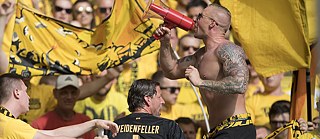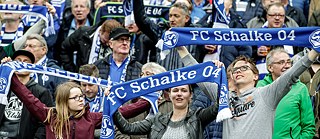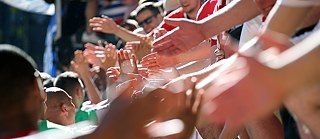Football fan culture in Germany
Well-off Bavarians and Working Class Supporters from the Ruhr

FC Bayern München, Borussia Dortmund or FC St. Pauli? For football-mad Germany, the matter of which team to support is also a question of identity and ideology.
Von Berni Mayer
“The fan club model remains the Bundesliga’s greatest weapon” – is how an English football activist, writing in the magazine 11 Freunde in March 2018, praised the fact that German football has remained comparatively resistant to all-out commercialization. Germany is home to around 25,000 clubs. Our selection illustrates how special the relationship really is between German fans and their clubs, and which role is played for example by the political orientation of clubs and the social milieu to which they belong.
FC Bayern München: used to winning
FC Bayern, the undisputed Bundesliga number one with six championship wins in a row, is regarded as a club with a fanbase of whinging light opera-lovers and mainstream spectators. This ignores the fact that Munich is home to well-networked groups of particularly fanatical supporters. Known as “ultras”, they get together for instance to combat racism. Season tickets priced at 140 euros for the terraces and 750 euros for first-class seats in the stands automatically put the club’s fans in the better-income bracket.Borussia Dortmund: being a fan is hard work
Supporters of Borussia Dortmund, the club that is forever hot on the heels of Bayern München, have the reputation of being particularly loyal and steadfast even in times of crisis. This at least is what is suggested by the claim of “true love” made by fans and the club itself – renouncing the capitalist excesses and transfer mania of the 1990s. BVB fans like to define themselves as being more genuine and upstanding that those of their arch-rival Bayern München. Indeed the “yellow wall”, the south stand of the club’s home stadium with room for over 80,000 spectators, is an impressive show of fan identification. Against this backdrop, it is sometimes easy to forget that even a club like Dortmund is guided primarily by economic interests, something that its fans support not only with their ideology, but also with record attendance numbers of up to 1.4 million per season.FC Schalke 04: Ruhr club and arch-rival

RB Leipzig: the non-traditional club
RB (Rasenballsport) Leipzig is a relative newcomer in the battle for the top spots in the league. Founded in 2009, the club is 99 percent owned by the Red Bull corporation. Often maligned by fans and the specialist press alike as a “plastic club”, it effortlessly rose from the fifth to the first division. It has even already played in the Champions League. Although people mockingly claim that there is no such thing as an original Leipzig fan, every match draws crowds of 30,000. All the same, the Red Bull Arena, which is home to the RB Leipzig, has not been sold out for some time.Energie Cottbus: a beast from the East?
Energie Cottbus, one of the few remaining GDR clubs and currently in the third Bundesliga division, is much talked about for the negative headlines it generates. The racist slurs chanted by several hundred right-wing extremist Cottbus fans during a match in April 2017 resulted in a nationwide campaign entitled Nazis raus aus den Stadien (i.e. Get Nazis out of the stadiums). In May 2018, Cottbus fans posed wearing white Ku Klux Klan-style hoods. Meanwhile the club’s management is attempting to counter the image of its fans as pyromaniacs and right-wing extremists – and is calling upon the large but less vocal section of the fan base to take action to combat xenophobia with a view to “conveying a genuine picture of the football fans of our club”.FC St. Pauli: good guy pirates
